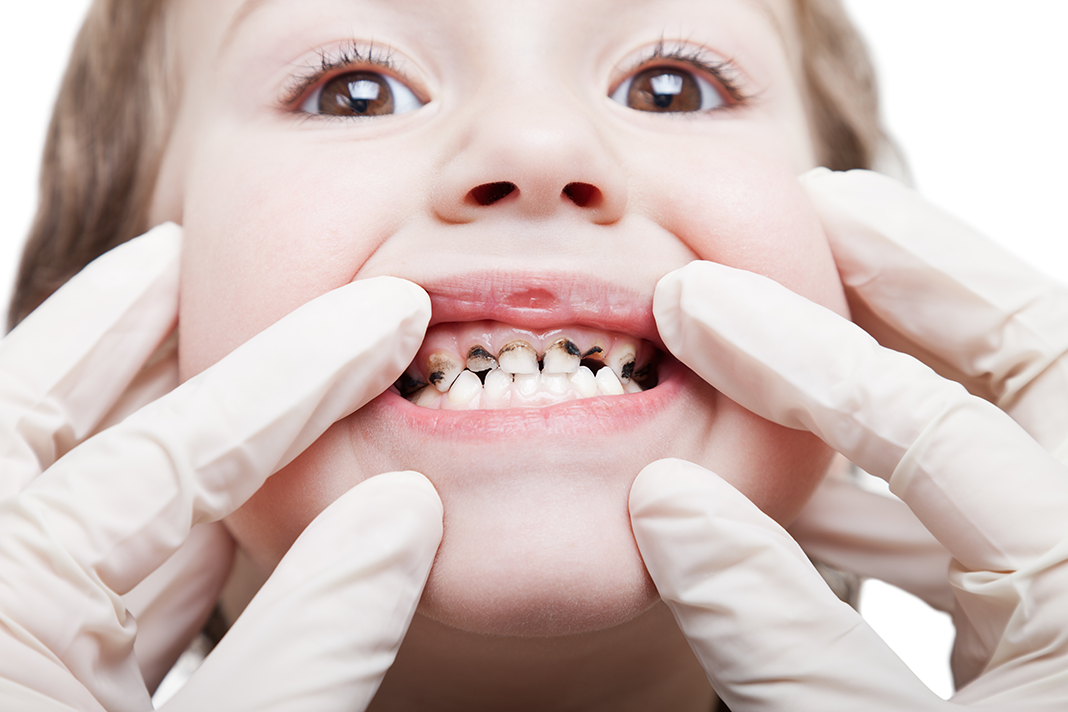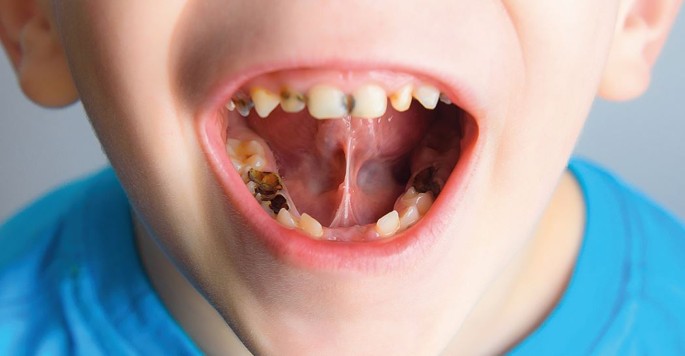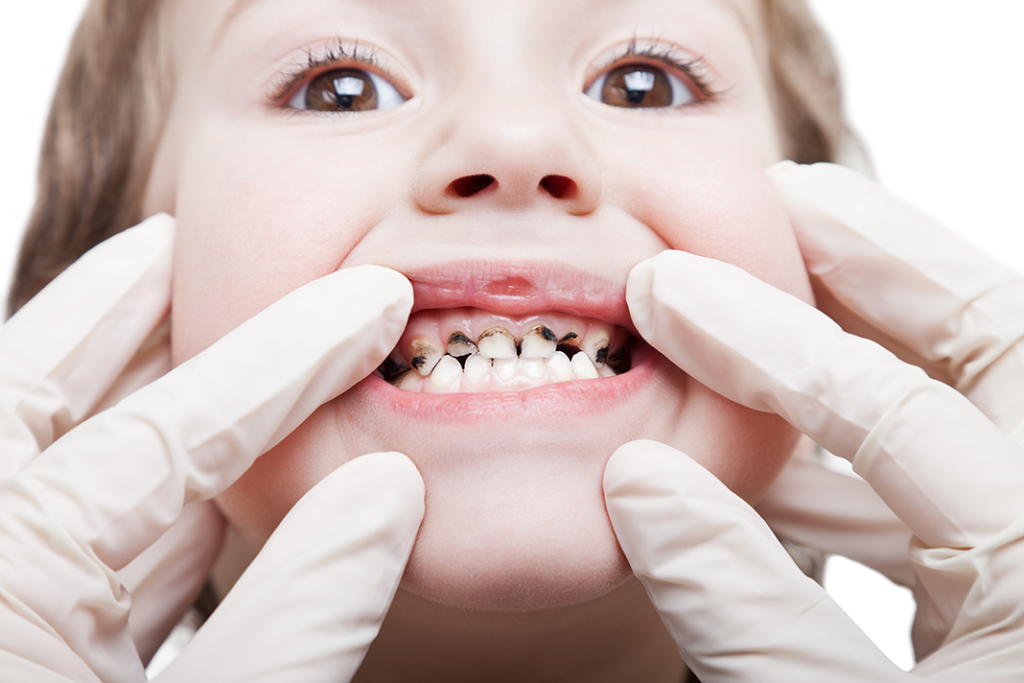
What are cavities?
We often associate dental caries in adults, with poor oral hygiene, and the intake of foods that are seen as unhealthy (gummies, sugar gum, etc.). Although it is true that both poor oral hygiene and foods with a lot of refined sugars are, most of the time, synonymous with the presence of cavities, they are not the only determining factors in the appearance of this disease.
First, it is worth explaining what dental decay is in children or in childhood dental care is. We are facing a disease caused by different types of bacteria present in our oral cavity. The activity of cariogenic bacteria causes demineralization of the hard tissues of the tooth, creating a process of progressive dental destruction, from the surface of the tooth to the innermost part. If this process is not stopped in time and dental caries reach the inner layers, the bacteria will infect the nerve-vascular bundle of the tooth, causing pain and necessitating the devitalization of the tooth.
The mouth, in childhood dental care, is one of the only parts of the body that is in continuous contact with the outside. In addition, due to food, it is a cavity in which food remains are regularly deposited, creating a perfect environment for the bacteria that inhabit. The bacteria responsible for producing tooth decay feed on sugars, therefore, it is safe to say that the best method to prevent tooth decay is to have proper oral hygiene and to reduce sugar intake as much as possible, especially refined sugars.

Does dental decay in children only on our oral hygiene and whether or not we eat sugar?
Although it is true that these factors are the two fundamental pillars in the appearance of cavities or dental decay in children, there are other factors that also influence the appearance of this disease. Basically, we can talk about the fact that three risk factors must enter the scene for the disease to appear. These are cariogenic bacteria, a susceptible person or tooth, and a suitable environment. When we speak of personal susceptibility, we are basically referring to the “quality” of tooth enamel, the type of saliva & the individual’s immune response. While when we talk about the environment, we refer to the type of diet and socioeconomic and cultural factors.
Risk factors to dental decay in children:
Therefore, to prevent tooth decay in childhood dental care, each of the risk factors will have to be addressed, and this means that:
- The cariogenic bacteria must be reduced with a good oral hygiene method.
- The susceptibility of dental tissues must be reduced and their remineralization promoted in the initial stages of the disease. We achieve these thanks to the action of fluoride. That is why it is important to use toothpaste that contains this element.
- Diet, which is usually the highest risk factor and most difficult to control. However, when we talk about the type of diet we are not only referring to the decrease in sugars. But there are other considerations to take into account. For example, foods or drinks with an acidic pH will favor dental erosion, which will indirectly favor the appearance of cavities by weakening the dental structure. In addition, these foods cause acidification of the oral environment, creating a more suitable environment for the survival of cariogenic bacteria. For this reason, apart from sugary foods and drinks, it is necessary to control the consumption of carbonated drinks, vinegar, lemon, cider, etc.
As basic dietary recommendations to prevent tooth decay is:
- Reduce your sugar intake.
- In addition to the quantity, the frequency of consumption of sugar and sweet products must be reduced.
- It is necessary to reduce the consumption of “sticky foods ” since they adhere to the dental surface and are difficult to remove with the tongue or with brushing.
- Eating sugar-free gum between meals helps maintain high levels of saliva in the mouth, which is beneficial for protecting against tooth decay.
- Education is very important, in terms of hygiene standards and prevention of oral diseases. Carrying out campaigns in schools teaching brushing techniques, for example, and teaching the population to have a control visit with their trusted dentist every 6 months.
Oral care of the little ones
Now that we know what tooth decay is and how we can prevent it, we are going to focus on the oral care of the little ones. Children at birth do not have the presence of cariogenic bacteria in their mouths. These bacteria will colonize the oral cavity, mainly, through the child’s closest caregivers. The maternal and paternal levels of cariogenic bacteria will therefore influence the levels of bacteria in the child. Thus, we can come to the conclusion that it is important to take care of both our oral hygiene and that of our children and that, knowing that saliva is the method of transmission of cariogenic bacteria.
Although we can try to reduce or delay this bacterial colonization, it is impossible to avoid it. Therefore, it is very important that we start with oral hygiene education for children as soon as possible. It is considered that the first visit to the pediatric dentist should be at one year of age, which is approximately when the child will have erupted anterior incisors (4 up and 4 down). It is during this visit that the professional will instruct the parents on oral hygiene measures.
3-year-olds
Once the first milk teeth begin to erupt and in children under 3 years of age, parents should brush, a minimum of twice a day and, above all, before going to sleep. The best technique for brushing is to stand behind the child, with the child sitting on the lap and facing both in the same direction. We must pay special attention to the upper arch, which is where the first cavities usually appear, raising the lips to check that there are no stains on the teeth.

Children from 3 to 6 years
In children 3 to 6 years of age, it is important to involve them in the oral hygiene process. Parents will brush first, without paste. Next, the child will do it, imitating the parents, with a little pasta (an amount similar to the size of a pea). Age-specific toothpaste should contain low concentrations of fluoride.
Children older than 6 years
Children older than 6 years, should be the ones who progressively acquire greater responsibility for their hygiene, nevertheless, they should always be supervised by their parents. They will use fluoride toothpaste and, gradually, they will be introduced to the dental floss in their daily hygiene.
However, we have already explained that the appearance of caries not only depends on the presence of bacteria but also that susceptible teeth and a favorable environment are needed. Therefore, in children, it will be necessary to apply the same measures that we mentioned previously. In addition to good oral hygiene, it is very important to control the diet, eliminating refined sugars as much as possible and, even more, if they are consumed in hooky format or in juice format (industrial juices, sweets, sugars, drunk yogurts), and acidic drinks or foods (especially carbonated drinks, which, in addition to being acidic, usually contain large amounts of sugar). Occasionally, professional fluoridations can be applied in children at high risk of cavities and, of course, it is vitally important to go, every 6 months, to follow-up visits with your trusted dentist to obtain a professional assessment.

